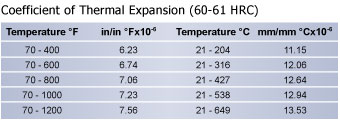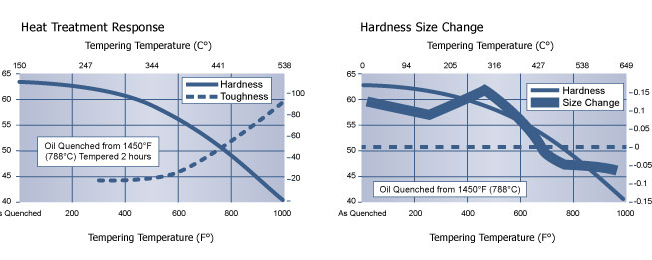O6 Cold Work Tool Steel
O6 tool steel is an oil-hardening, graphitic tool steel with outstanding resistance to metal-to-metal sliding wear and galling. The steel contains a uniform dispersion of graphite particles, which impart excellent machinability and non-seizing characteristics. The graphite particles make the steel self-lubricating in dry environments, and help to retain oil in lubricated environments.
O6 tool steel can be hardened to over 60 Rockwell C from a relatively low hardening temperature, which minimizes size change and distortion during heat treatment.
APPLICATIONS: Thread gauges, master gages, cams, bushings, sleeves, meat granulator plates, arbors, forming rolls, shear blades, punches, dies, bar feed guides and other machine tool parts.
Composition
| C | Mn | Si | Mo |
| 1.45 | 1.00 | 0.90 | 0.25 |
Relative Properties


Physical Properties
- Density: 0.278 lb/in3 (7695 kg/m3)
- Specific Gravity: 7.70
- Modulus of Elasticity: 30 x 106 psi (207 GPa)
- Machinability: 125% of a 1% carbon steel

Heat Treating Instructions
Hardening
Preheating: Heat at a rate not exceeding 400°F per hour (222°C per hour) to 1200-1250°F (649-677°C) and equalize.
Austenitizing (High Heat): Heat slowly from the preheat to 1450-1550°F (788-843°C).
Less than ½ inch (12.7mm) thickness: use 1450°F (788°C)
½ to 2 inches (12.7 to 51mm) thickness: use 1475°F (802°C)
Over 2 inches (51mm) thickness: use 1500°F (816°C)
Quenching: Oil or pressurized gas.
For oil, quench to 150 - 125°F (66 - 51°C)
For pressurized gas, the quench rate to below 1000°F (538°C) should be a minimum of 400°F 222°C) per minute, and is critical for obtaining the desired properties.
Tempering: Temper immediately after quenching. The typical tempering range is 300 - 400°F (149 -204°C). Hold at temperature for 1 hour per inch (25.4 mm) of thickness, 2 hours minimum, then air cool to ambient temperature. The actual hardness obtained is dependent upon the section size of the part being quenched and tempered. To minimize internal stresses in cross sections greater than 3 inches (76.2 mm) and to improve stability in parts that will be EDM'd after heat treatment, a soaking time of 4 to 6 hours at the tempering temperature is strongly recommended.
Cryogenic Treatment: Refrigeration treatments should typically be performed after the temper, and must be followed by a second temper.
Annealing
Annealing must be performed after hot working and before re hardening.
Heat at a rate not exceeding 400°F per hour (222°C per hour) to 1450°F (816°C), and hold at temperature for 1 hour per inch (25.4mm) of maximum thickness, 2 hours minimum. Then cool at 10°F (5.5°C) per hour to 1300°F (704°C). Then cool at 25°F (14°C) per hour from 1300°F (704°C) to 1000°F (538°C). Then cool in air to ambient temperature. The resultant hardness should be a maximum of 229 HBW.